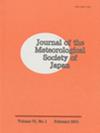准地转系统中方位波数为1的生长涡罗斯比波
IF 1.6
4区 地球科学
Q3 METEOROLOGY & ATMOSPHERIC SCIENCES
引用次数: 1
摘要
在这项研究中,我们分析表明,在基本轴对称涡旋中,方位波数为m=1的涡旋Rossby波(VRW)可以在准地转系统中呈指数增长,尽管在正压系统中不能这样做。如果满足Rayleigh条件和Fjørtoft条件,则VRW呈指数增长。满足瑞利条件意味着在两个不同半径的两个水平排列的VRW在方位角上相互反向传播(此处和下文中“传播”指的是相对于流体的传播)。满足Fjørtoft条件意味着基本涡旋的气旋平流角速度呈径向分布,从而使VRW能够相互锁相。在这些条件下,VRW之间的强烈相互作用成为可能,因此它们呈指数级增长。在正压系统中,即使满足瑞利条件,具有方位波数m=1的VRW的方位反传播也非常强,以至于它们之间不能发生锁相,因此它们不能指数增长。然而,在准地转系统中,第一斜压垂直模式的上下VRW大小相等,符号相反。由于这种斜压结构,水平排列的VRW的方位角反向传播受到上部和下部VRW之间的垂直相互作用的抑制。因此,具有方位波数m=1的水平对准的VRW可以变成锁相的,并且因此它们可以指数增长。通过解析求解准地转系统中VRW的线性问题,我们证明了事实确实如此。本文章由计算机程序翻译,如有差异,请以英文原文为准。
Growing Vortex Rossby Waves with Azimuthal Wavenumber One in Quasigeostrophic System
In this study, we show analytically that vortex Rossby waves (VRWs) with azimuthal wavenumber m = 1 in a basic axisymmetric vortex can grow exponentially in a quasi-geostrophic system, although they cannot do so in a barotropic system. VRWs grow exponentially if Rayleigh’s condition and Fjørtoft’s condition are satisfied. Satisfying Rayleigh’s condition means that two horizontally aligned VRWs at two different radii propagate (here and hereafter “propagate” refers to propagation relative to the fluid) azimuthally counter to each other. Satisfying Fjørtoft’s condition means that the cyclonic advective angular velocity of the basic vortex is distributed radially so as to enable the VRWs to be phase-locked with each other. Under these conditions, a strong mutual interaction between the VRWs becomes possible, and thus they grow exponentially. In a barotropic system, even if Rayleigh’s condition is satisfied, the azimuthal counter propagation of VRWs with azimuthal wavenumber m = 1 is so strong that phase-locking between them cannot occur, and thus they cannot grow exponentially. In a quasi-geostrophic system, however, the upper and lower VRWs of the first baroclinic vertical mode are equal in magnitude and have opposite signs. Because of this baroclinic structure, the azimuthal counter propagation of the horizontally aligned VRWs is suppressed by the vertical interactions between the upper and lower VRWs. Consequently, horizontally aligned VRWs with azimuthal wavenumber m = 1 may become phaselocked, and hence they may grow exponentially. By analytically solving the linear problem of VRWs in a quasigeostrophic system, we show that this is indeed the case.
求助全文
通过发布文献求助,成功后即可免费获取论文全文。
去求助
来源期刊
CiteScore
6.70
自引率
16.10%
发文量
56
审稿时长
3 months
期刊介绍:
JMSJ publishes Articles and Notes and Correspondence that report novel scientific discoveries or technical developments that advance understanding in meteorology and related sciences. The journal’s broad scope includes meteorological observations, modeling, data assimilation, analyses, global and regional climate research, satellite remote sensing, chemistry and transport, and dynamic meteorology including geophysical fluid dynamics. In particular, JMSJ welcomes papers related to Asian monsoons, climate and mesoscale models, and numerical weather forecasts. Insightful and well-structured original Review Articles that describe the advances and challenges in meteorology and related sciences are also welcome.

 求助内容:
求助内容: 应助结果提醒方式:
应助结果提醒方式:


